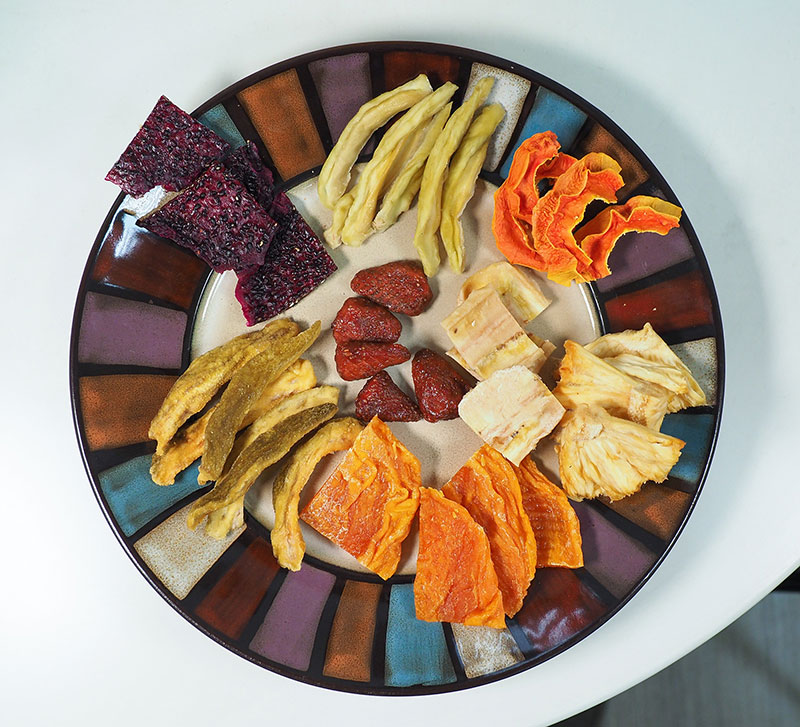
Drying fruit at low temperatures concentrates the sweetness as the moisture evaporates, making a healthy and delicious snack.
Fruit is best eaten in season right where it is grown. But what if in the chill of winter you want to eat summer fruits like mango or lychee? The answer lies in the old saying “spring cultivation, summer weeding, autumn harvesting, and winter storage.” If you transform tropical fruits by dehydration or cooking, concentrating their flavors into dried fruits or jams, you can capture their magnificent tastes and enjoy them all year round.
For fruits like mangoes from Yujing, pineapples from Guanmiao, longans from Dongshan, and pomeloes from Madou—all in Tainan—the place name has become a brand name. We took advantage of the warm winter sun of Southern Taiwan to visit the SunnyGoGo fruit processing factory in Guiren, which is close to all of these fruit growing locales. As soon as you enter the plant your nose is assailed by a rich fragrance of fruit. Nick Chen, manager of SunnyGoGo, says they chose to set up in Guiren because of the convenience of transporting fruit there.
The fruity scent comes from dragon fruit (pitaya) that workers are cutting up at that moment. Chen says that this is the ‘Da Hong’ variety from Pingtung County. The ripe fruit has deep red flesh and a delicate texture. After 40 hours of drying, it becomes more fragrant and sweeter, without adding sugar. You can still taste the distinctive aroma of dragon fruit, and it has a granular texture like eating sesame seeds.

Depending on the pineapple variety used, the filling in pineapple cakes can be sweet or tart.
Additive-free
SunnyGoGo is one of Taiwan’s leading producers of additive-free dried fruit. They do not add preservatives, coloring, or flavoring agents, but simply select fruit such as mangoes, pineapples, and papayas that meet their sweetness requirements and dry them at low temperatures. As the water content evaporates, the sweetness is concentrated, making the fruits into healthy, delicious snacks.
The company’s peak production season begins in March, starting with pineapple, followed by guava and dragon fruit. In July they start drying mango, their leading product, along with ‘Mei Chiao’ ABB bananas, roselle flowers, papaya, and star fruit. After low-temperature drying the fruit fragrance is even stronger. With Tainong No. 2 papaya, for example, after around 15 chews there is an explosion of taste in your mouth like a papaya milk drink. ‘Mei Chiao’ bananas have soft and chewy flesh, and remain soft and chewy after drying, making them a nutritious snack suitable for children and the elderly, with the scent of banana and a taste like natural fruit gummy candy.

Nick Chen (right) contracts with a young farmer nicknamed “Big Bear” to produce pineapple for drying.
Promoting Taiwan
Nick Chen was born in Tainan’s Nanxi District, known as “the home of fruit.” Besides growing mango, it is Taiwan’s biggest producer of star fruit, and the area cultivated with jujube ranks third nationwide. Chen and his wife Chen Yi Qian, a fine arts teacher, founded SunnyGoGo ten years ago. Their initial goal was to promote fruits from their hometown. As well as drying fruit, they also ship premium-quality fresh jujubes, Irwin mangoes, and Yuhebao lychees to Japan by air. Chen says in his authentic Tainan accent that fruit from other countries cannot match the refinement of fruit from Taiwan.
Besides SunnyGoGo, we also visit the Green Bee Jam factory, which has both ISO 22000 and HACCP certifications. Even though the visitors’ walkway is separated from the processing area by glass, you can still smell the rich fragrance of their fruit fillings.
Green Bee vice president Kevin Wang notes that among the company’s fruit products, mango and passion fruit have the highest acceptance worldwide. The fillings they make with these two fruits can be widely used in cakes, dorayaki, and red bean cakes. The fruit sauces, meanwhile, are mainly used in cold tea drinks and salads, or on tofu pudding and ice cream. Taiwan’s Irwin mangoes, for example, have a pronounced flavor, and when concentrated into a filling or sauce, are more fragrant than mangoes from other countries, helping Green Bee’s products stand out from the competition. They work with a partner company to produce frozen mango pancake dough for export to the US.
The diverse uses of Taiwanese fruit go far beyond enabling summer fruit to be eaten in winter. As Nick Chen points out, fresh fruit has a limited storage life. Fruit can only be transported over long distances and stored for long periods if it is processed. Drying makes it possible to market Taiwan’s high-quality tropical fruit to the whole world.
For more pictures, please click 《Fruitful Endeavors: The Many Uses of Taiwanese Fruit》











